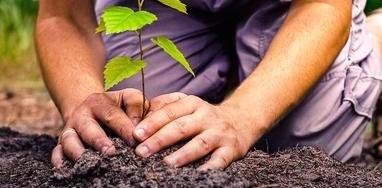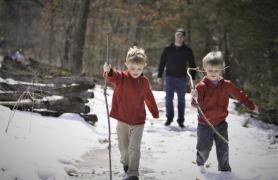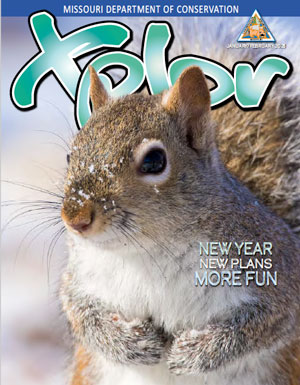Conservation is a big word for a simple idea. It means taking care of nature so kids like you — and your kids and their kids and all who come after — can explore a fall forest, fish in an Ozark stream, or watch an eagle soar over a foggy marsh. Conservation means leaving nature better off than when you found it.
Here are a few things you can do throughout the year, by yourself or with a grown-up, to give nature the boost it needs.
Bash Some Trash
Pick a trail or wild place near your house and promise to keep it trash-free for the rest of the year.
Feed Your Feathered Friends
Birds search for seeds all winter long. By February, pickings are slim, and feathered foragers welcome an easy meal. Setting up a bird feeder is a great way to keep your beak-tipped buddies happy and flappy. For tips on where to put your feeder and what to fill it with, fly over to short.mdc.mo.gov/ZCS.
Stack Some Sticks
Brush piles are like critter hotels. Cozy crannies between branches offer “rooms” where rabbits, sparrows, and other animals take shelter. To build a brush pile, ask a grown-up to cut down branches. Stack the thickest branches at the bottom and pile smaller ones on top. Keep stacking until you have a tangly pile about head high and 20 feet wide.
Recycle Your Christmas Tree
After the holidays, strip your Christmas tree of ornaments and tie a concrete block to its trunk. Ask a grown-up to help you drag the tree onto a frozen pond. (Don’t walk on ice unless it’s at least 8 inches thick!) When the ice melts, the tree will sink and become a place where fish can hide from predators, rest in safety, and raise their babies.
Build a Nestbox
Eastern bluebirds begin raising babies in early March. Make sure they have a home tweet home by building a nestbox. Grab a grown-up to help with construction and download the building plans at audubon.org/news/how-build-bluebird-nest-box.
Plant a Tree
Arbor Day, which Missourians celebrate on the first Friday in April, is about appreciating trees. Trees clean the air, keep soil from washing into rivers, provide homes for animals, and offer shade to people. What’s the best way to celebrate this leafy holiday? By planting a tree, of course! For tips, branch out to mdc.mo.gov/trees-plants/tree-care.
Leave Little Critters Alone
Late spring is when baby animals start turning up in backyards. Keep your pets inside so they can’t harm these easy-to-catch critters. And if you find a baby bird, newborn bunny, or small fawn, leave it alone. It isn’t abandoned. Mom’s probably hiding nearby and won’t return until you leave.
Push Back on Pesticides
Pesticides are chemicals used to kill weeds and pesky insects. But they also harm good plants and helpful insects like bees and butterflies. This spring, ask your parents to spray fewer pesticides or avoid using them altogether.
Prevent a Crash Landing
Glass is often invisible to birds, and up to a billion die each year when they fly headfirst into windows. Most crashes occur during spring migration. To prevent them, paint a picture on the outside of large windows. Use washable tempera paint, which is long-lasting but comes off with a damp sponge and some scrubbing.
Beware of Speed Bumps
In April, box turtles trudge across roads to look for mates and places to lay eggs. You can help them make it across safely. First, make sure it’s safe to be on the street. Then, pick up the turtle by the back of its shell and carry it to the side of the road in the direction it was going. Afterwards, wash your hands with soap and water.
Free Your Fish
If you don’t intend to eat your catch, release a fish carefully so it has the best chance to survive. If possible, don’t take a fish out of the water. If you must, wet your hand before handling it. Don’t squeeze the fish too hard, and never put your fingers in its eyes or gills. If the fish has swallowed the hook, don’t remove it. Cut the line instead.
Bee Helpful
Bumblebees are VIBs — very important bugs! They carry pollen from flower to flower, which helps plants make seeds. But some of Missouri’s bumblebees are in trouble. You can help biologists learn how they’re doing in your area by counting bees for the Missouri Bumblebee Atlas. For details, buzz over to mobumblebeeatlas.org.
Count Some Quail — and Turkeys, Too
Northern bobwhites and wild turkeys are two of the Show-Me State’s best known birds. To keep track of their numbers, biologists need folks across Missouri to count them. To learn how to help, flock to mdc.mo.gov/wildlife/wildlife-surveys.
Adopt a Stream
Streams are nature’s blood vessels, and about 110,000 miles of water-filled arteries flow through Missouri. Join a Stream Team to check water quality, pick up litter, improve habitat for aquatic critters, and nurse sick streams back to health. For details, flow over to mostreamteam.org.
Grow Native
Bees, butterflies, and other pollinators are disappearing in alarming numbers. To bring back the buzz, plant native wildflowers in your yard. Native plants are adapted to Missouri’s weather, they need less water, and they provide the best food for wildlife. For ideas about what to plant, flutter over to grownative.org.
Tag Monarchs
In mid-September monarch butterflies flutter south to Mexico. You can help biologists track their movements by catching migrating monarchs and putting identification tags on their wings. To learn more, flitter over to monarchwatch.org.
Multiply Milkweed
For every monarch you see today, 20 years ago there were four more. You can help bring their numbers back up by collecting milkweed seeds — a monarch caterpillar’s favorite food — and planting them in your yard. For a detailed growing guide, visit short.mdc.mo.gov/4Nr.
Leave the Leaves
Fallen leaves add nutrients to the soil, create a layer of mulch that holds moisture in the ground, and provide a blanket that protects insects and other animals during winter. So give your rake a break, and let leaves lie on the ground until spring.
Follow the Rules
Hunting and fishing regulations keep people safe, give all Missourians a fair chance to catch a fish or harvest a deer, and ensure wildlife numbers are healthy now and in the future. Whether you’re sitting in your deer stand or duck blind, be sure to follow the rules!
Bash Bush Honeysuckle
Bush honeysuckle is an invasive shrub that’s eating Missouri. It spreads quickly and crowds out critter-friendly plants. Because it stays green after other plants turn brown, fall is the perfect time to find and remove it. For honeysuckle-busting tips, visit short.mdc.mo.gov/ZCi.


Also In This Issue

Getting fit is fun when you unleash your inner animal.
And More...
This Issue's Staff
Photographer – Noppadol Paothong
Photographer – David Stonner
Designer – Marci Porter
Designer – Les Fortenberry
Art Director – Cliff White
Editor – Matt Seek
Subscriptions – Laura Scheuler
Magazine Manager – Stephanie Thurber























